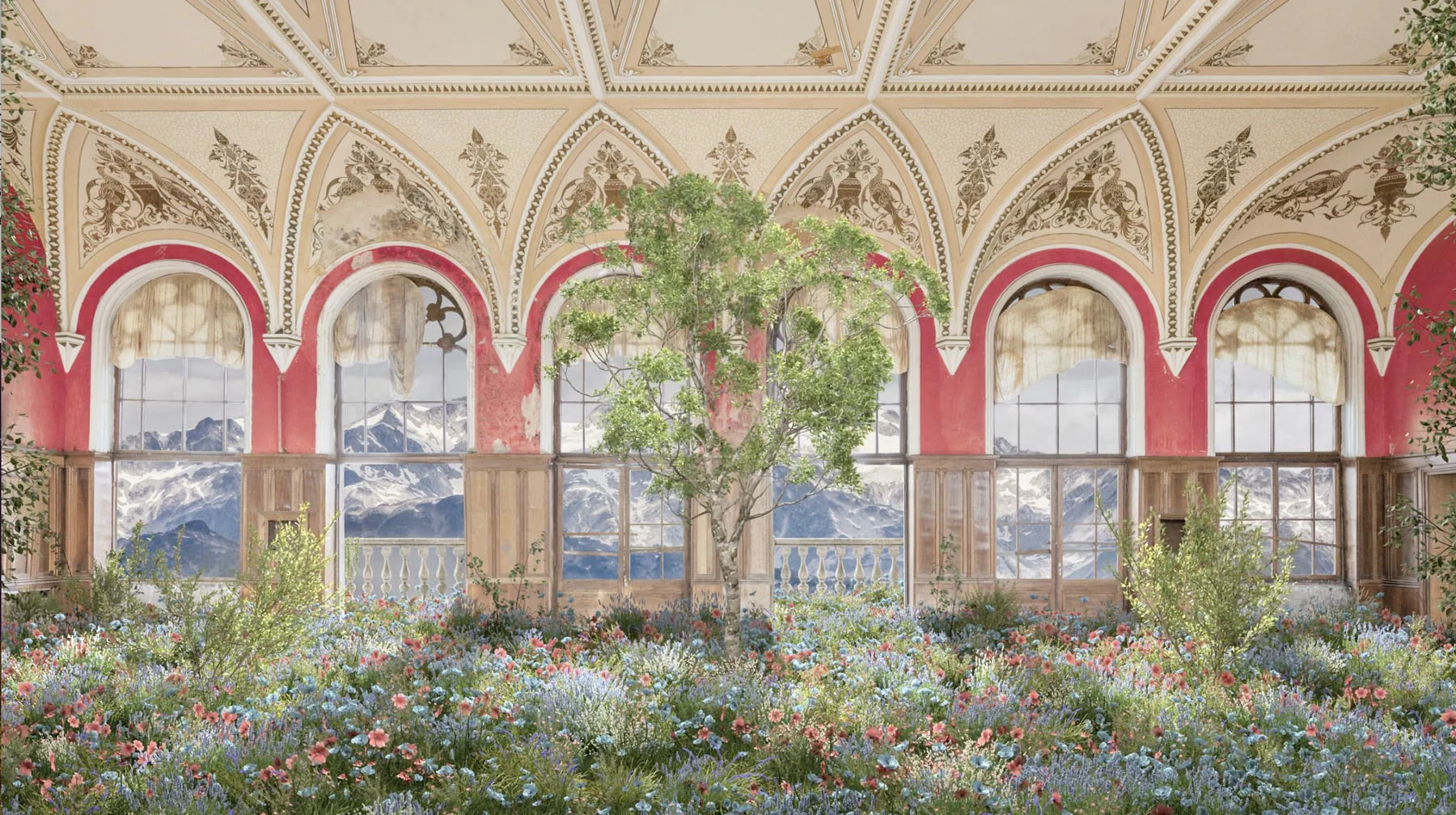
Ruins never fail to remind us of the power and ruthlessness of time. For their project “The Wild Within,” photographer Ryan Koopmans and digital artist Alice Wexell have been working together to digitally revive forgotten, abandoned spaces, giving them a second life in the digital realm by injecting them with renderings of beautiful foliage, not only to breathe organic new life into them, but also to show the way nature will eventually overcome them. Writer Joe Zadeh explores how their project brings the past and the future—and the real and imaginary—together in the form of surreal, tranquil scenes you could stare at for hours.
This article was curated in collaboration with Wildxyz.

There is something perverse about the pleasure of seeing ruins. It’s the spectacle of fallen worlds; the place where the story came to an end. Abandoned man-made structures reclaimed by nature and engulfed in vegetation make us contemplate not just the past but also the future; the unstoppable cyclical processes taking place all around us, at timescales that are barely comprehensible.
It’s a troubling thought for some. Perhaps that’s why famous ruins, like the Colosseum in Rome—which was once covered green in over 420 species of plant—have been stripped bald of nature’s creative destruction. Likewise, the ruins of castles and abbeys in the UK are often surrounded by immaculately kept lawns.
This cyclical relationship of growth and decay is at the heart of “The Wild Within,” a visual art project by the Dutch-Canadian photographer Ryan Koopmans and the Swedish digital artist Alice Wexell that breathes new life into forgotten spaces. Koopmans describes their work as “lens-based art”—a careful choice of words that embodies the state of flux that the field of photography is in right now, as new advanced technologies are once again reshaping what it means to capture an image.
The pair scout out abandoned buildings that have a rich historical context and striking or unique architectural characteristics. They then photograph the interiors in 360 degrees; an incredibly time-consuming process. “It’s essentially photogrammetry,” explains Koopmans. “Thousands of images are taken of the interior, and then constructed to form a 3-D model. The process involves visual documentation from all different angles to get a real-scale representation of the interior as well as the textures within.”
Once the ultra-realistic 3D model is complete, Koopmans and Wexell add “digital foliage,” furnishing the ornate spaces with renderings of grasses, mosses, ferns, wildflowers and trees that are bursting through the floor and crawling up the walls. The abundance of flora is exaggerated to poignantly gesture at the explosion of new life that will repossess these forgotten places. In the final digital artworks—which are normally exhibited on screens as looping animations, or as immersive VR experiences—the plants gently sway, as if a breeze was passing through the picture.
“A big part of the work is about reviving these architectural spaces and giving them a new life,” says Koopmans. “By adding the foliage, and turning the image of the architecture into a digital artwork, the idea is to recontextualize the architecture and introduce it to a new form of existence on the block chain.”
Koopmans met Wexell in New York, where she was working as a web developer and coder. He gave her a camera as a present, and the two began taking photography trips together. They’ve since traveled all over the world in search of ruins, from Southern and Central Europe to the Middle East. The first of the trips to yield artworks was Georgia, where they made repeat visits to the ghostly former Soviet spa town of Tskaltubo, Georgia.
During the 1950s, Tskaltubo became a thriving resort known for its ancient “life-giving” waters, and it was populated with luxurious hotels, bath houses and sanatoriums. Even Joseph Stalin himself visited. “And then upon collapse of the Soviet Union in the early 90s, it became basically abandoned overnight,” says Koopmans. “It's a very recent example of a collapsed empire; a country that just doesn’t exist anymore.”
Every culture has its own standards of beauty, encapsulated in its arts and its architecture. “The Wild Within” reveals the intrinsic beauty of a far greater collaboration, between the elemental forces of nature and the terraforming forces of humanity. And there is a breathtaking power in seeing these works entangled: the architectural masterpieces of human culture entwined in the biological masterpieces of nature.

Understandably, time is out of joint in these artworks. Each one creates the sense of a perpetual moment, one in which the architectural setting stretches backwards in time—not just to 20th century Soviet Russia, but far beyond, to the Ancient Greek and Roman motifs of neoclassical Stalinist architecture—while the accelerated greenery points forward. They may have the appearance of ancient ruins, Koopmans says, “but, in fact, they’re only 35 or 40 years old.”
“I think it’s fascinating, because it has a timeless quality and it’s something that’s bigger than us,” says Koopmans. “You have these grandiose ideologically-based societies or empires, and as powerful as they may be, time erases it all, essentially. Nature is the one constant force that prevails.”
Koopmans and Wexell are repeatedly reminded that these forgotten places they love to capture are only forgotten for so long. Nature isn’t the only rampant force around: The rapid construction of megacities and their associated infrastructure is spreading a wave of speculation, demolition and construction across the planet. In Georgia—a country undergoing a seismic construction boom—Koopmans tells me they scouted an abandoned school in Tbilisi to shoot, but when they returned, just a week later, it was gone. Not just reduced to rubble, but utterly disappeared—enough to make them question their maps—only a dark stretch of dirt remaining where it had once been.

